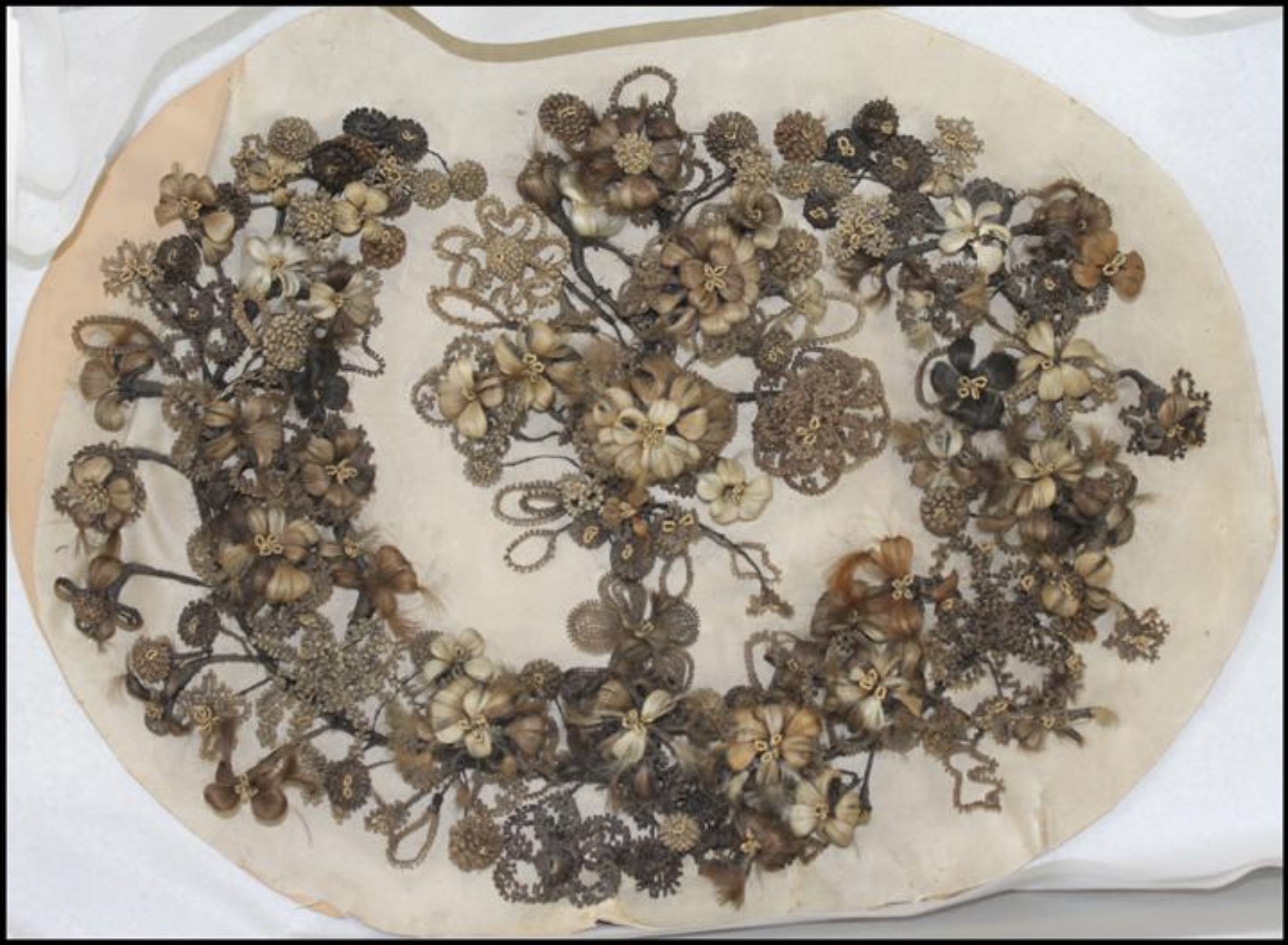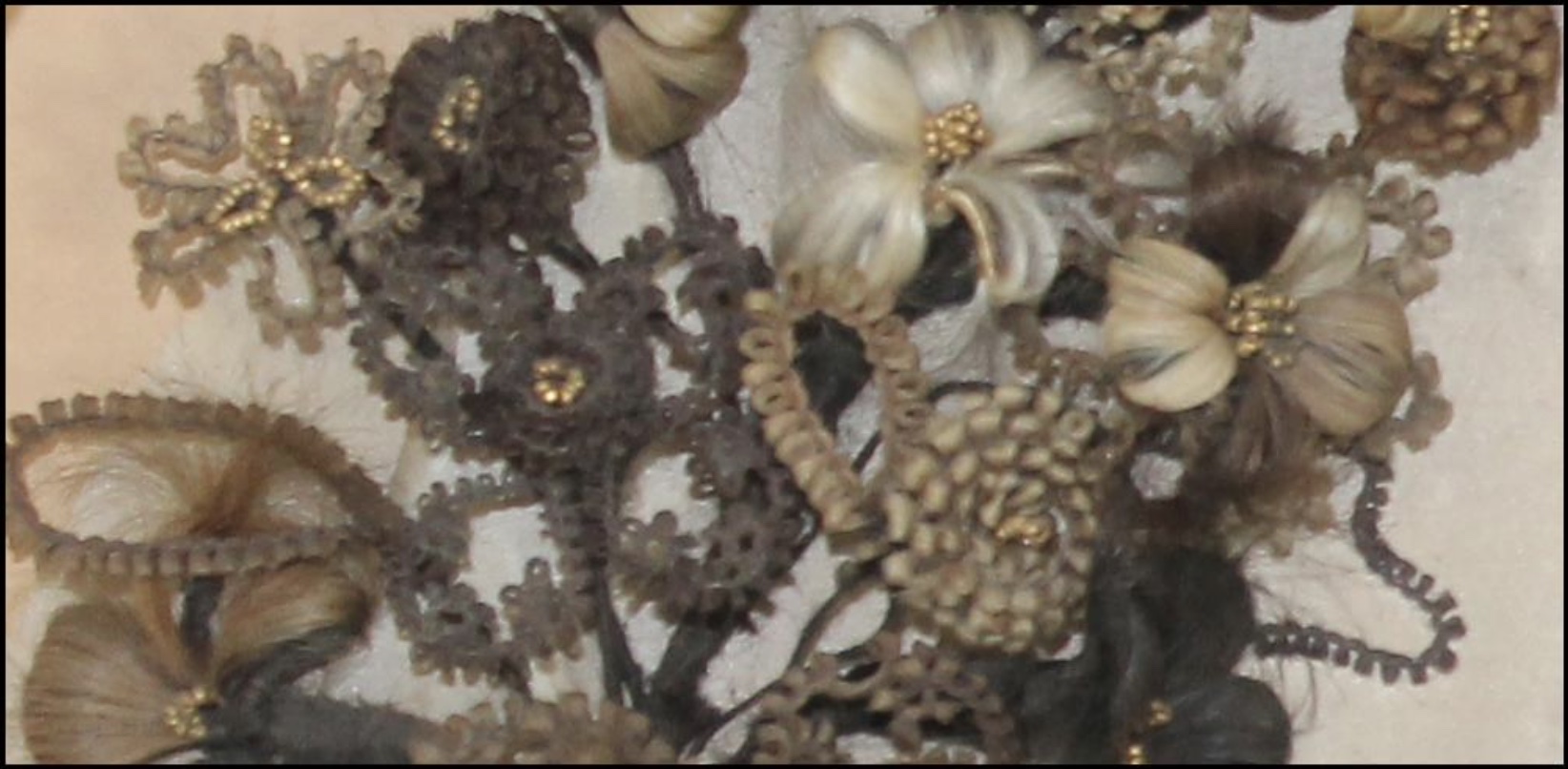
Needham History: Hair Work
Unique, intimate, and incredibly durable.

The unframed hair wreath, showing a range of colors, from white to black. The hair was woven into flowers, buds, and stems on an armature of wire and embellished with glass beads.
Hair Work
Several years ago, we staged a brief “Pop-Up” exhibit to go along with our History of Needham in 100 Objects exhibit. These were advertised as Objects 101-120 – objects that came close, but did not make the final cut because they were either too creepy, too boring, or just because we did not know enough about them. It was a fun concept, and we will revisit it again sometime. Kind of like the junk food of museum collections. A diet of high-minded historical context is all well and good, but be honest – sometimes what you really want is the Mummy’s Hand, or the Lock of Hair of John Wilkes Booth.
One of the objects (in the Creepy category) was the Floral Vignette Made of Human Hair. Creepy to us, anyway; in its own time it was perfectly normal.
Ashes to ashes, all flesh is grass, and all that. The one exception is keratin, the fibrous tissue that makes up your hair and nails. Hair is amazingly durable, and holds it shape and color over very long periods of time. It is unique and intimate, both a part of your body and a major component of your visual appearance. For those reasons, hair became the primary focus of mourning objects; you could literally hold onto a piece of your beloved.
This practice reached its peak in the 19th century, as Mourning became a form of public expression as much as it was an expression of private grief. This was inspired in part by imitation of Queen Victoria, who wore formal mourning for her husband Prince Albert from his death in 1861, until hers in 1901. It was also a consequence of the heavy losses of fathers, husbands, and sons during the Civil War. Locks of hair were worked into jewelry such as rings and brooches, or into small keepsake wreaths, which you could wear or carry with you. It could also be ground into a sort of pigment, often used to paint a vignette on a mourning brooch or as the background for a lock of hair. The craft was known as Hair Work.
On a larger scale, locks of hair from several people were often worked into an elaborate wreath or other form, and framed for display. The differing colors gave the composition its pattern and texture. The complexity of the arrangement was an indication of the scope of loss and memory. They were probably added to over time.
In the days before photography was readily available, portraiture was expensive and keeping a lock of hair was often the only way to retain some vestige of a loved one’s appearance. In the later 19th century, when photography became more accessible, posthumous portraits became fashionable. These range from the unintentionally- humorous (the two huge lumberjacks supporting their tiny grandmother’s coffin between them); through the mawkish and sentimental (the just-gone-to-sleep genre); to the truly horrifying (just don’t ask). Photography and the turn of the 20th century brought an eventual decline to the art of hair work.
While I am happy to say that I have not yet found any posthumous portraits in our collection, we do have examples of hair work. Several of these are small rings and wreaths, wrapped in labelled slips of paper, that were found in the desk of physician Josiah Noyes. These were not displayed, but they were kept where Noyes would have encountered them daily – keeping these people alive in his thoughts as he went about his day.
The most elaborate examples in our collection are a pair of floral vignettes, presumably for parlor display. They probably date to the second half of the 19th century, but we (alas!) do not have a lot of information about them. One is still in its gilded oval frame; the other is no longer framed. Both are in the form of large wreaths (they are about 15 inches wide) and woven from many colors of hair. Colors range from blond to almost-black, with one or two very bright reds.
The unframed wreath also has a fair number of whites and grays, but the framed one has very few. There are two possible reasons for this – the most obvious is people died younger in those days. The other is that it is not a mourning wreath, but a “friendship” wreath. Friendship wreaths were rarer, but based on a similar impulse – a group (family, church society, or other close unit) would give locks of hair to be woven together into a sort of group portrait to commemorate their relationship. Maybe the framed wreath with the younger hair is one of these. We can hope, anyway.
Although their hair survives, nothing else about the people represented in these vignettes is known to us anymore. We can ourselves mourn that such a large and intimate gathering has been lost to us. But while the knowledge of their friends and families have faded, we can make sure that their memento endures in the collective memory of our community.
Close-up detail from the hair wreath, showing the wired construction and beading, and some of the variety of colors.

 |
Gloria Polizzotti Greis is the Executive Director of the Needham History Center & Museum. For more information, please see their website at www.needhamhistory.org. |

